Research - (2021) Volume 0, Issue 0
TWINSPAN classification of vegetation from South East aspect of Lower Tanawal, Pakistan
A. Bibi1* and Z. Jamal2Abstract
The aim of present research study was to explore the vegetation of Lower Tanawal, Pakistan from South East aspect. The ordination techniques Two-way Indicator Species Analysis (TWINSPAN), Detrended Correspondence Analysis and Canonical Correspondence Analysis were used to classify the data. TWINSPAN classified the 157 species and 14 stands into four plant communities namely Pinus-Polygala-Chenopoddium, Pinus-Berberis-Daphne, Acacia-Olea-Dodonaea and Punica-Pyrus-Rubus community. The present study will provide the baseline information about the South East aspect of vegetation of Lower Tanawal, Pakistan.
Keywords
TWINSPAN, Vegetation, South East aspect, DCA, CCA, Lower Tanawal.
Introduction
Multivariate techniques were used in this phytosociological study. The analysis of the floristic data is done by the TWINSPAN. TWINSPAN is a classification technique for the classification of stand and species (Hill, 1979). The main focus of the CCA is to determine the species relationship with environment variable. The DCA analysis determines the relationship among vegetation. (Antoine and Niklaus, 2000).
Study areaThe Lower Tanawal located in District Abbottabad Khyber-Pakhtunkhwa Pakistan. It lies between the 34°12' 328 and 34°15´761 north latitude to 73°09'398 and 73°03´316 east longitudes (Bibi, et al., 2019). The Lower Tanawal is part of the Lesser Himalayas. The Lesser Himalayas comprise on whole area of Hazara division (Hussain and Ilahi, 1991).
Materials and Methods
The survey of the vegetation of the Lower Tanawal, Pakistan from south east aspect was conducted from 2016-2018 in different seasons. Line transects method was used to determine the vegetation of south east aspect of the Lower Tanawal. Measuring tape of 50 meter was used between two poles to measure the distribution of plants. Sampling was confined to those plants that were touching the line (Dasti, et al,. 1998). During field survey of south east aspect 157 plant species were recorded from 14 stands. The relative values of plants studied in 14 stands were calculated. Data of 157 plant species, from 14 stands along with environmental variables was analyzed in MS EXCEL 2007, computer programmes. The data was organized according to the requirement of the PC-ORD (McCune, 2006). Plants communities were documented based on TWINSPAN classification. Based on first three dominant plants specie each plant community was given name. TWINSPAN was used to classify species and samples (Hill, 1979). DCA technique was used for ordination of samples and specie (RA; Hill 1973, Gauch, 1980). CCA technique was used for the ordination of species, sample and their relationships to environmental variables (Ter Braak, 1986, 1994).
Results
Through TWINSPAN classification 157 plant species and 14 stands were recorded. On the basis of indicator species the data were classified into two major groups. In division 1 the eigenvalue was 0.55. Thirteen stands were put in negative groups (*0) where 1 stand was placed in positive group (*1). In division 2 one stand was placed in negative group (*00) while 12 stands were placed in positive group (*01). In division 3 seven stands were put in negative group (*00) while five stands were put in positive group (*01). Then four plant communities like Pinus-Polygala-Chenopoddium, Pinus-Berberis-Daphne, Acacia-Olea-Dodonaea and Punica-Pyrus-Rubus community were documented (Fig. 1).
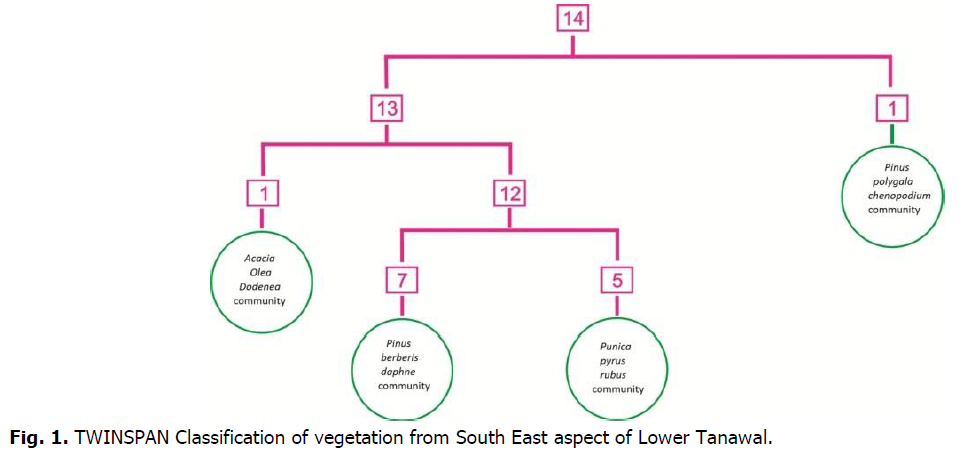
Fig 1. TWINSPAN Classification of vegetation from South East aspect of Lower Tanawal.
Pinus-Polygala-Chenopodium community
In this community 24 plant species from 1 stand were noted. This community was documented from the locality of Kharagali at the altitude of 6742 feet. The diversity index was 0.89. The species richness was 2.78 (Fig. 2). The dominant life form was Therophytes with 11 plant species (Fig. 3). Dominant leaf spectra was Microphyll with 11 plant species (Fig. 4).
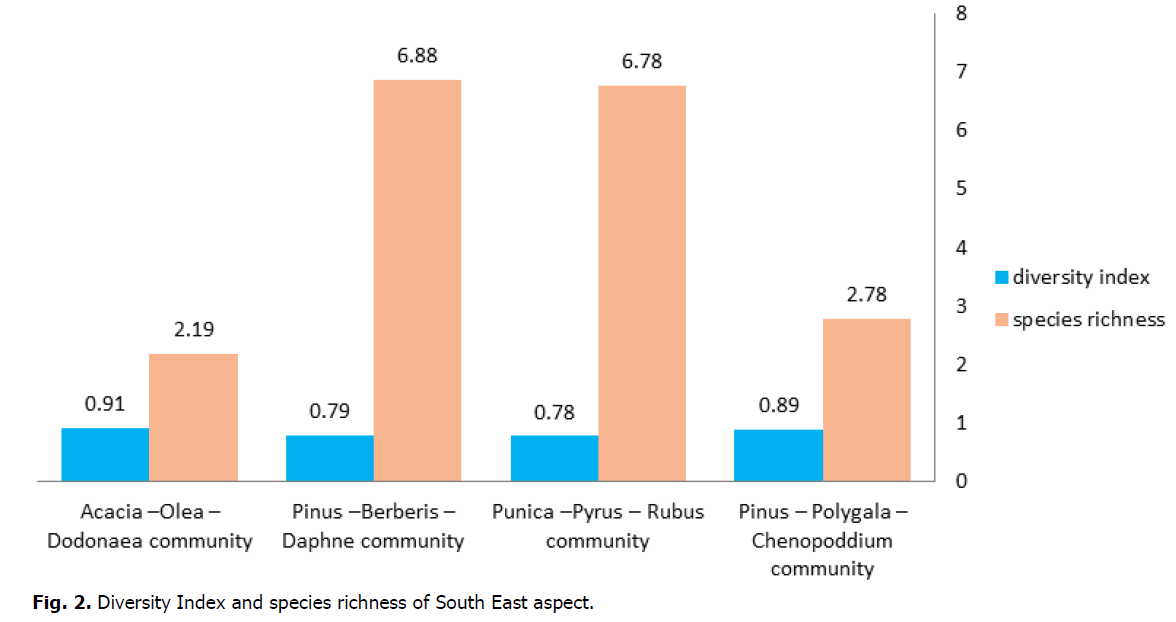
Fig 2. Diversity Index and species richness of South East aspect.
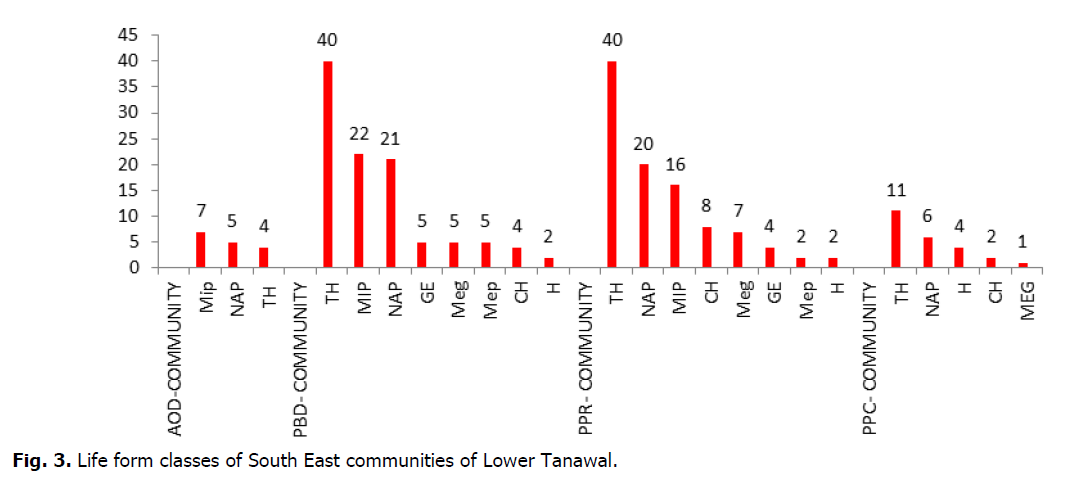
Fig 3. Life form classes of South East communities of Lower Tanawal.
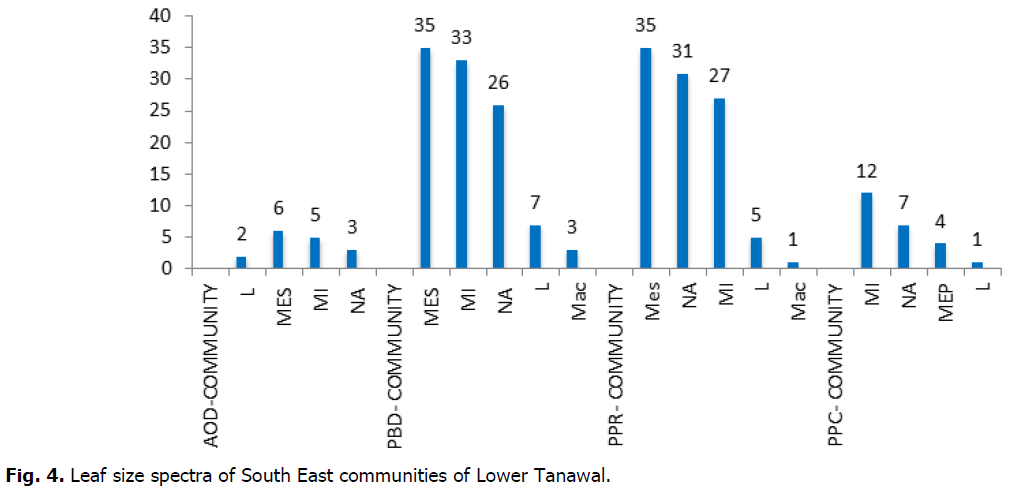
Fig 4. Leaf size spectra of South East communities of Lower Tanawal.
Pinus-Berberis-Daphne community
Seven stands and 104 plant species were noted. It was recorded from the localities of Sherwan Kalan, Chariala, Thana, Pawa, Panduthana, Siyal and Khuliala between the altitudes of 3590 to 4902 feet. The diversity index was 0.79. The species richness was 6.88 (Fig. 2). Dominant life form was Therophytes with 40 plant species (Fig. 3). Dominant leaf spectra was Mesophyll with 35 plant species (Fig. 4).
Acacia-Olea-Dodonaea community
From the locality of Fateh Bandi at the altitude of 3025 feet, 1 stand and 16 plant species were documented. The diversity index value was 0.91. The species richness value was 2.19 (Fig. 2). Microphanerophytes was dominant life form with 07 plant species (Fig. 3). Dominant leaf spectrum was Mesophyll with 06 plant species (Fig. 4).
Punica-Pyrus-Rubus community
It was recorded from the localities of Mubaraak, Mundarra,Talhar and Thathi Faqeer I,II between the altitudes of 4045-4629 feet. Five 5 stands and 99 plant species were documented. The index of diversity was 0.78. The species richness was 6.78 (Fig. 2). The dominant life form was Therophytes with 40 plant species (Fig. 3). Dominant leaf spectra was Mesophyll with 35 plant species (Fig. 4).
DCA ordination of vegetation of lower Tanawal from South East aspect
In DCA ordination, for axis 1 the maximum gradient length was 4.76 and Eigenvalue was 0.55. For axis 2 gradient lengths was 2.28 with 0.29 Eigenvalue. The gradient length for axis 3 was 2.41 with Eigenvalue 0.21. The gradient length for axis 4 was 1.96 having Eigenvalue 0.09. Total variance in the species data was 3.42. The dominant gradient length showed maximum species resemblances on axis 1.
DCA analyses presented that Geranium ocellatum, Viola odorata, and Verbascum thapsus have positively correlated with each other at axis I. Mallotus philippensis, Dodonaea viscosa, Acacia modesta and Parthenium hysterophous were positively correlated with each other on axis 2. Caryopteris odorata, Calamagrostis acutiflora, and Aristida cyanantha shown positive correlation with each other and negatively correlated with Cotoneaster integerrimus and Artemisia absinthium. Cyperus niveus and Cirsium falconeri, indicatedpositive correlation with each other and negatively correlated with Carissa opaca (Fig. 5). Stand 02 indicated negative correlation with stand 75 whereas Stands 38 negatively correlated with stand 72. (Fig. 6).
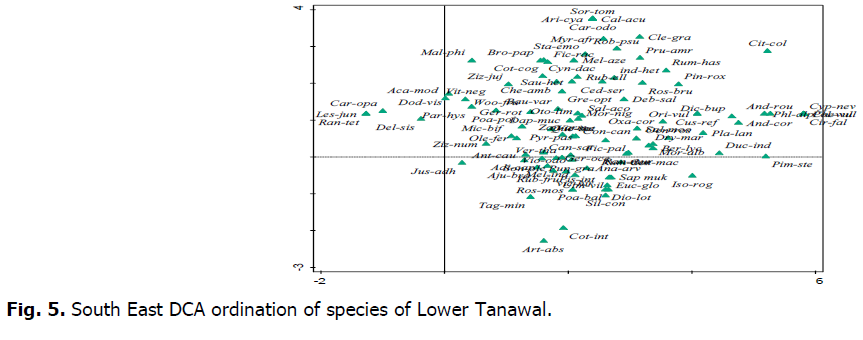
Fig 5. South East DCA ordination of species of Lower Tanawal.
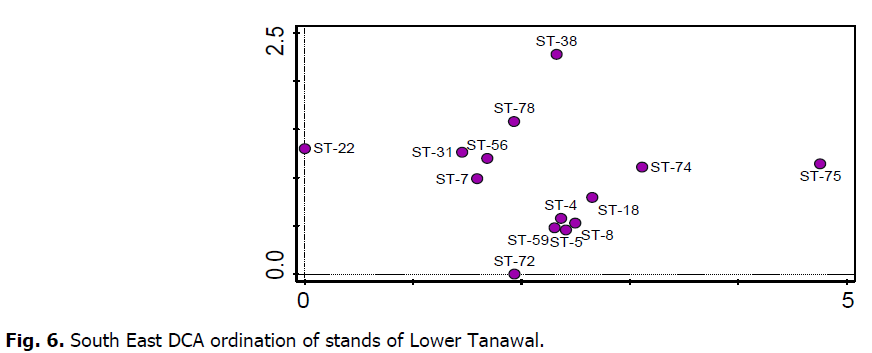
Fig 6. South East DCA ordination of stands of Lower Tanawal.
CCA ordination of vegetation of lower Tanawal from South East aspect
CCA ordination indicated that the maximum Eigenvalue for axis I was 0.55 for axis 2 was 0.47 for axis 3 was 0.33 and for axis 4 was 0.29. The explained variation for axis 1, axis 2, axis 3 and axis 4 were 16.10, 29.86, 39.69 and 48.36, respectively. The total variation was 3.42, explanatory variables account for 100.0%, while adjusted explained variation were 0.0%. The pseudo-canonical correlation for axis 1, for axis 2, for axis 3 and for axis 4 was 1.00. The explained variations for axis 1, for axis 2, for axis 3 and for axis 4 were 16.10, 29.86, 39.69 and 48.36 respectively. The permutation test results for all axes were pseudo-F<0.1, P=1.
The CCA ordination indicated that Acacia modesta, Vitex negundo and Ziziphus nummularia were positively correlated with heat index and negatively correlated with humidity. Duchesnea indica, Populous alba, showed positive correlation with saturation and electrical conductivity. Salvia moorcroftiana, Cannabis sativa, revealed positive correlation with potassium and negative correlation with wind speed and slope angle. Dicliptera bupleuroides, Andrachne cordifolia, and Pinus roxburghii, indicated positive correlation with chillnes, wind speed, heat index, dew point, wet bulb and phosphorus (Fig. 7). The environmental variables dew point, slope angle, chillness, phosphorus, wind speed and altitude showed positive correlation with each other and negative correlation with organic matter and potassium. Heat index and temperature and positively correlated with each other and negatively correlated with humidity, barometer pressure and electrical conductivity. CCA ordination of stands indicated that stand 24 which was present at the top of the ordination space showed more diverse species as compare to other stands. Maximum vectors strength was recorded for heat index and altitude. The intermediate vectors strength was noted for organic matter; wet bulb, wind speed, dew point, chillness, temperature and barometer pressure (Fig. 8).
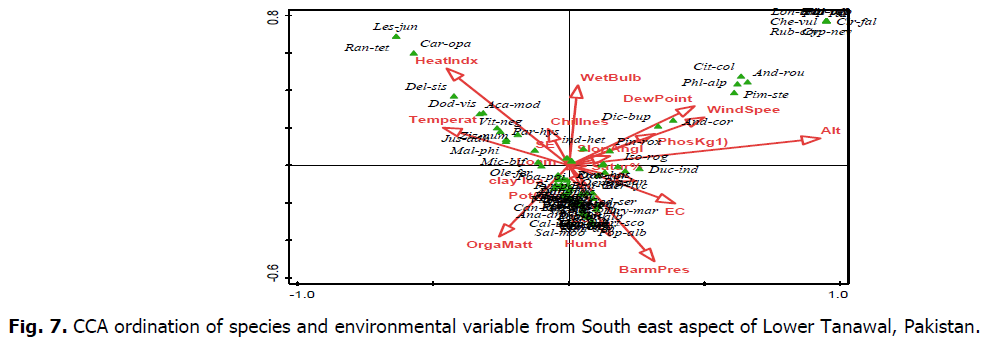
Fig 7. CCA ordination of species and environmental variable from South east aspect of Lower Tanawal, Pakistan.
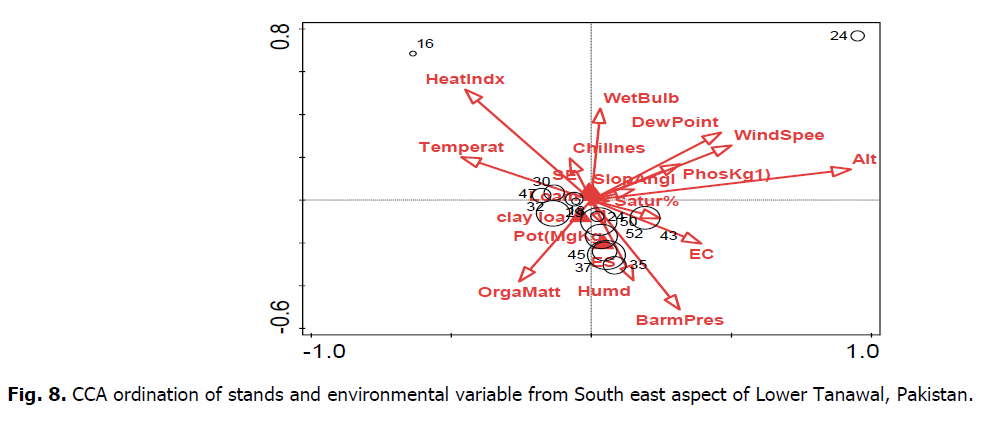
Fig 8. CCA ordination of stands and environmental variable from South east aspect of Lower Tanawal, Pakistan.
Conclusion and Discussions
The South east Detrended correspondence analysis showed the highest gradient length (4.76) was noted for axis 1 with Eigenvalue 0.55. The CCA ordination of stands presented that mostly stands were positively correlated with environmental variables. Our findings are agreed with Mahmood et al. (2015) described distribution of plant species on axis 1. They also stated that environmental factors affect the vegetation.
Microphylls and mesophylls were dominant leaf spectra. Leaf size classes indicated that some species are sensitive to heat stress and water. Our results are in line Haq et al.(2015) stated and mesophylls and microphylls were dominant leaf spectra from Nandiar forests of Battagram, Pakistan. Therophytes was dominant life form which showed disturbed environment in the study area and biotic pressure on vegetation which increases the short live species. Our findings are agreed with the Farag (2014), Ali et al. (2016), Saxena et.al. (2004), (Malik et al., 2013; Malik 2007) that showed biotic pressure effect the vegetation.
References
Dasti, A.A, Malik, S.A. (1998). A transect of vegetation and soil on the indus valley scarp slope, Pakistan. Pakistan Journal of Plant Science, 4:73-84.
Hussain, F., Ilahi, I. (1991). Ecology and Vegetation of Lesser Himalayas Pakistan. Jadoon Printing Press Peshawar.
Farag, El.M. (2014). Floristic composition and traditional uses of plant species at Wadi Alkuf, Al-Jabal Al-Akhder, Libya. American-Eurasian Journal of Agriculture Environment, 14:685-697.
Haq, F., Ahmed, H., Iqbal, Z. (2015). Vegetation composition and ecological Gradients of subtropical-moist temperate ecotonal forests of Nandiar Khuwar catchment, Pakistan. Bangladesh Journal of Botany, 44:267-276.
Hill, M.O. (1979). TWINSPAN:A FORTRAN program for arranging multivariate data in an ordered two-way table by classifcation of the individuals and attributes. Ecology and Systematics, Cornell University, Ithaca, NY.
Bibi, A., Iqbal, Z., Shah, G.M. (2019). Floristic diversity, biological spectrum of Lower Tanawal, KP, Pakistan. Ukrainain Journal of Ecology, 9:505-514.
Hussain, F., Illahi, I. (1991). Ecology and Vegetation of Lesser Himalayan Pakistan. Botany, Department. University of Peshawar, pp:187.
Hill, M.O., Gauch, H.G. (1980). Detrended correspondence analysis: An improved ordination technique. Vegetation, 42:47-58.
Malik, N.Z., Arshad, M., Mirza, S.N. (2007). Phytosociological attributes of different plant communities of pir chinasi hills of azad Jammu and Kashmir. International Journal of Agriculture Biology, 9:569-574.
Malik, Z.H., Hussain, F., Malik, N.Z. (2007). Life form and leaf size spectra of plant communities Harbouring Ganga Chotti and Bedori Hills during 1999-2000. International Journal of Agriculture Biology, 9:833-838.
Mehmood. A., Shah, A.H., Khan, S.M., Shah, A.H., Rehman, I., Ahmad, H. (2015). First floristic exploration of the district Tor Ghar, Khyber Pakhtunkhwa, Pakistan. Pakistan Journal of Botony, 47:57-70.
McCune, B. (1986). PC-ORD: an integrated system for multivariate analysis of ecological data. Abstract Botony, 10:221-225.
Saxena, A.K., Pandey, P., Singh, J.S. (2004). Biological spectrum and other structural functional attributes of the vegetation of Kumaun Himalaya. Plant Ecology, 49:111-119.
Ter Braak, C.J.F., Barendregt, L.G. (1986). Weighted averaging of species indicator values: Its efficiency in environmental calibration. Mathematical Biosciences. 78:57-72.
Ter Braak, C.J.F. (1989). CANOCO-an extension of DECORANA to analyze species-environment relationships. Hydrobiologia, 184:169-170.
Author Info
A. Bibi1* and Z. Jamal22Department of Botany, Govt Post Graduate Collage Abbottabad Khyber Pakhtunkhwa, Pakistan
Citation: Bibi, A., Jamal, Z. (2021). TWINSPAN classification of vegetation from South East aspect of Lower Tanawal, Pakistan. Ukrainian Journal of Ecology 11 (8), 106-110.
Received: 17-Sep-2021 Accepted: 15-Oct-2021 Published: 25-Oct-2021
Copyright: This is an open access article distributed under the terms of the Creative Commons Attribution License, which permits unrestricted use, distribution, and reproduction in any medium, provided the original work is properly cited.
